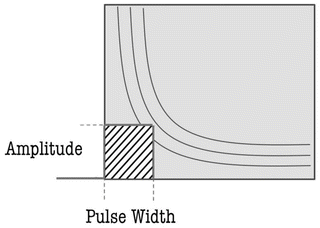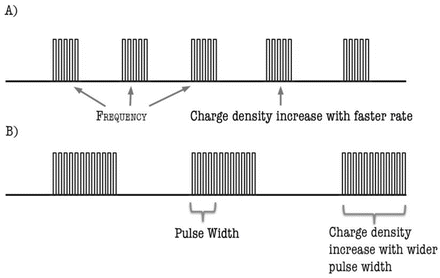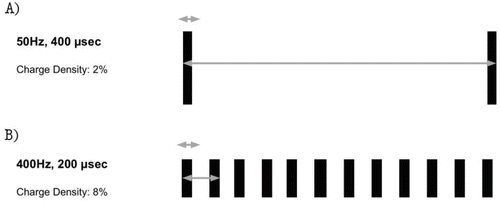Fig. 50.1
The concept of charge as dose is illustrated. In this example, each pulse can be thought of as a therapeutic dose or the charges per second as a total dose
Description of High-Density Stimulation
As seen in Fig. 50.2, whenever the amplitude and pulse width of various programs are plotted, a strength-duration curve is created. The concepts underpinning the strength-duration curve have been the mainstay of convention SCS programming for several decades. Whenever frequency is added into the framework, the focus begins to shift from strength duration to one of charge delivered per second. Each individual strength-duration pulse added to the number of these pulses in a given second results in a duty cycle [pulse density] or amount of time during each second that charge is being delivered. In conventional SCS, charge is not being delivered during the vast majority of time during a second [Fig. 50.3]. Increasing charge density with higher-frequency stimulation creates more time in charge delivery mode. As can be seen in this example, conventional stimulation at 50 Hz and 400 μs creates charge for significantly lesser time during the 1 s time period than does the subsequent example of 300 Hz at 400 μs. This would be analogous to a radio station that played five songs per hour with no other programming. The time between songs would be dead air. Increasing charge density in SCS decreases the amount of ‘dead air’, which is hypothesized to change treatment responses.



Fig. 50.2
Strength duration curve at a given amplitude or pulse

Fig. 50.3
More charge can be delivered per second by (panel A) increasing frequency of charge delivered or (panel B) increasing pulse width
The duty cycle , demonstrated in Fig. 50.4, can be altered by either increasing pulse width or frequency and either strategy will result in more time during the given second, whenever charge is being delivered. In Fig. 50.5, various scenarios are presented which demonstrate how to calculate the duty cycle [pulse density] of higher-frequency stimulation platforms. For example, a frequency of 200 Hz, with pulse width of 1000 μs per pulse, would result in a duty cycle of 20% [200 Hz × 1000 μs=200,000 μs of charge delivered in 1 s]. Since there are one million microseconds in 1 s, the time of charge delivery [in this example 200,000 μs] divided by the total number of microseconds in 1 s is 0.2 or 20%. This simple calculation allows one to determine the total duty cycle of a stimulation platform. Likewise, example two in Fig. 50.5, with a frequency of 500 Hz and pulse width duration of 500 μs, results in a duty cycle of 0.25 or 25% [{500 Hz × 500 μs}/1,000,000 μs in 1 s= 0.25]. Currently available SCS systems can produce 1200 Hz at 200 μs, resulting in a duty cycle of 24%. Though not displayed in Fig. 50.3, one can easily calculate the duty cycle of the 10,000 Hz stimulation platform and [10,000 Hz × 30 μs] as 30%.



Fig. 50.4
Duty cycle (charge density) can be influenced by increasing frequency, pulse width or both

Fig. 50.5
Dosing strategies: point density
Some investigators began describing conventional or tonic SCS as low density, which would correspond to <5% duty cycle [i.e. less than 5% of a second is occupied by charge delivery], while high-density stimulation platforms deliver charge for >20% of the duty cycle [20% of the second consists of charge delivery] [7]. From a biophysiologic standpoint, the rationale is described as follows: once a nerve was stimulated, it would have a relative refractory period, during which repeat delivery of charge would be non-beneficial. However, investigators discovered that higher-frequency stimulation may activate different neurons within the dorsal horn giving differing clinical results. The higher duty cycle achieved may stimulate the wide dynamic range neurons of the dorsal horn [3, 10]. Other investigators postulate that since some neurons within the nervous system deliver action potentials in bursts, while others produce a tonic pattern, short bursts of high-frequency stimulation may improve clinical outcome [5]. It has been postulated that these patterns of activation within the dorsal horn may account for the observations that better analgesia can be obtained often without the presence or perception of paresthesia. While both 10,000 Hz stimulation and burst stimulation platforms are working through hypothetically differing mechanisms, they each have duty cycles above 20% and fall within the high-density conceptualization.
Literature Review
The higher frequency and ultimately higher duty cycle SCS platforms have increasing evidence, which suggests that multiple approaches can have efficacy. Recent work on the subject comes both from the laboratory and from clinical studies.
Animal Studies
As data began appearing with regard to 10 K Hz stimulation and burst stimulation models, investigators began examining the role of higher-frequency and charge density stimulation in animals. Schecter and colleagues, in an animal model of neuropathic pain, examined the effects of 50 Hz [conventional stimulation], 1 K, and 10 K Hz stimulation [10]. This study suggested that both 1 and 10 K Hz stimulation were significantly different than 50 Hz and sham, with 50 Hz providing some improvement over sham as well. This preliminary report also suggested a latency of onset of maximal result for the 50 Hz group, while the 1 K and 10 K Hz group had relatively immediate effects. Additionally, there was a difference in response to lower- and higher-intensity [corollary to differing amplitudes] stimulation. Taken together, the findings of differing times of onset, which include convention frequencies slower in onset of analgesia than higher frequency, and differing response to intensity of stimulation, which include higher-frequency stimulation responding to lower amplitude application required than the conventional or 50 Hz group, suggest that high-frequency stimulation is acting via a different mechanism to produce analgesia than conventional 50 Hz stimulation. An important implication of this animal study is that 1 K and 10 K stimulation performed similarly to animal models of hypersensitivity and neuropathic pain [10, 11].
Stay updated, free articles. Join our Telegram channel

Full access? Get Clinical Tree





